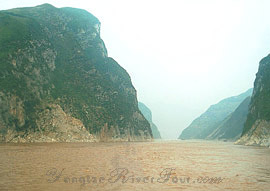The Mt. Wushan range lies on the border of the Sichuan and Hubei Provinces. It stretches its way from northeast to southwest connecting with the Daba Mountain in the north. Mt. Wushan has long been a place people pined to experience the majesty and grace of the twelve peaks. The Yangtze River weaves among the peaks creating the well-known Wu Gorge.
There are six peaks lying on each side of the river. On the north bank are Deng Long, Sheng Quan, Zhao Yun, Wang Xia, Song Liang and Ji Xian all of which can be seen when cruising on the Yangtze River. The peaks of Jing Tan, Qi Yun and Shang Sheng on the south bank are hidden behind the mountain ranges while the other three, namely Fei Feng, Cui Ping and Ju He are visible from the river. Names have been derived from a distinct characteristic of each. Wang Xia Peak, also known as the Goddess Peak, is on the north bank and attracts much more attention. At its summit there is a stele which is in shape of a maiden. Legend says that the maiden is the Goddess Yaoji who vanquished demons and monsters in the Yangtze River and helped Yu the Great (an ancient tribal leader in the 2nd century BC) to cut through the Three Gorges. Finally she is incarnated to the Goddess Peak guarding the gorges forever.
The mountains and peaks integrated myths and legends have been passed down from generation to generation. Poets adored the twelve peaks all through the ages and poems are too numerous to mention individually. The Twelve Peaks as a whole are such a masterpiece of nature that words only fail to describe their beauty. Come and view these gorgeous peaks encircled by their mist and clouds and you can live the subject of the amazing Chinese Brush Paintings.
Golden Helmet and Silver Armor
 Golden Helmet and Silver Armor is a vivid description of a unique cliff that lies in the Wu Gorge near the Hengshi Stream, 10 kilometers (6.2 miles) from Mt. Wushan. Viewed from afar, the pleated rocks spread over the precipice appear to be golden on top and silver on the bottom, resembling a warrior wearing a golden helmet and silver armor. These pleated rocks are typical of aqueous rocks that are compressed in the process of diastrophism, or deformation of the earth's crust.
Golden Helmet and Silver Armor is a vivid description of a unique cliff that lies in the Wu Gorge near the Hengshi Stream, 10 kilometers (6.2 miles) from Mt. Wushan. Viewed from afar, the pleated rocks spread over the precipice appear to be golden on top and silver on the bottom, resembling a warrior wearing a golden helmet and silver armor. These pleated rocks are typical of aqueous rocks that are compressed in the process of diastrophism, or deformation of the earth's crust.
In the south bank of the gorge, you can see a rock that very much resembles a mouse, resting in a cave known as the Mouse Cave. Near the Mouse Cave, there is a spot known as the Jianchuan Hole. Legend has it that this name originated when a hole was penetrated in the cave wall using an arrow by Xiang Yu, a well-known general in the Qin Dynasty (475 BC-221 BC). A stele erected behind the hole was said to be that arrow.
![]()
More Wu Gorge Attractions:
![]() Shennong Stream
Shennong Stream
![]() Three Little Gorges
Three Little Gorges
![]()

